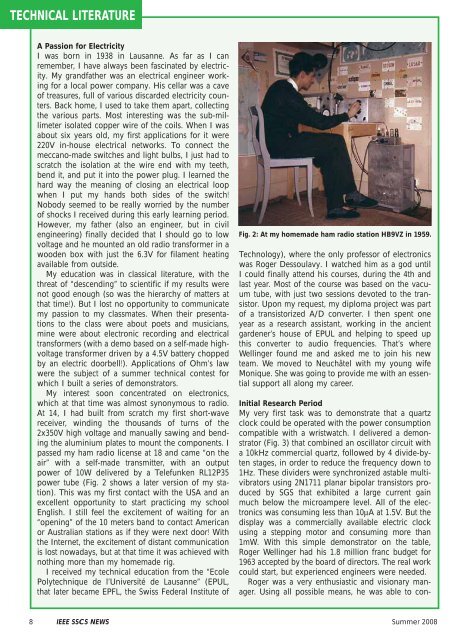Eric Vittoz - IEEE
Eric Vittoz - IEEE
Eric Vittoz - IEEE
You also want an ePaper? Increase the reach of your titles
YUMPU automatically turns print PDFs into web optimized ePapers that Google loves.
TECHNICAL LITERATURE<br />
A Passion for Electricity<br />
I was born in 1938 in Lausanne. As far as I can<br />
remember, I have always been fascinated by electricity.<br />
My grandfather was an electrical engineer working<br />
for a local power company. His cellar was a cave<br />
of treasures, full of various discarded electricity counters.<br />
Back home, I used to take them apart, collecting<br />
the various parts. Most interesting was the sub-millimeter<br />
isolated copper wire of the coils. When I was<br />
about six years old, my first applications for it were<br />
220V in-house electrical networks. To connect the<br />
meccano-made switches and light bulbs, I just had to<br />
scratch the isolation at the wire end with my teeth,<br />
bend it, and put it into the power plug. I learned the<br />
hard way the meaning of closing an electrical loop<br />
when I put my hands both sides of the switch!<br />
Nobody seemed to be really worried by the number<br />
of shocks I received during this early learning period.<br />
However, my father (also an engineer, but in civil<br />
engineering) finally decided that I should go to low<br />
voltage and he mounted an old radio transformer in a<br />
wooden box with just the 6.3V for filament heating<br />
available from outside.<br />
My education was in classical literature, with the<br />
threat of “descending” to scientific if my results were<br />
not good enough (so was the hierarchy of matters at<br />
that time!). But I lost no opportunity to communicate<br />
my passion to my classmates. When their presentations<br />
to the class were about poets and musicians,<br />
mine were about electronic recording and electrical<br />
transformers (with a demo based on a self-made highvoltage<br />
transformer driven by a 4.5V battery chopped<br />
by an electric doorbell!). Applications of Ohm’s law<br />
were the subject of a summer technical contest for<br />
which I built a series of demonstrators.<br />
My interest soon concentrated on electronics,<br />
which at that time was almost synonymous to radio.<br />
At 14, I had built from scratch my first short-wave<br />
receiver, winding the thousands of turns of the<br />
2x350V high voltage and manually sawing and bending<br />
the aluminium plates to mount the components. I<br />
passed my ham radio license at 18 and came “on the<br />
air” with a self-made transmitter, with an output<br />
power of 10W delivered by a Telefunken RL12P35<br />
power tube (Fig. 2 shows a later version of my station).<br />
This was my first contact with the USA and an<br />
excellent opportunity to start practicing my school<br />
English. I still feel the excitement of waiting for an<br />
“opening” of the 10 meters band to contact American<br />
or Australian stations as if they were next door! With<br />
the Internet, the excitement of distant communication<br />
is lost nowadays, but at that time it was achieved with<br />
nothing more than my homemade rig.<br />
I received my technical education from the “Ecole<br />
Polytechnique de l’Université de Lausanne” (EPUL,<br />
that later became EPFL, the Swiss Federal Institute of<br />
Fig. 2: At my homemade ham radio station HB9VZ in 1959.<br />
Technology), where the only professor of electronics<br />
was Roger Dessoulavy. I watched him as a god until<br />
I could finally attend his courses, during the 4th and<br />
last year. Most of the course was based on the vacuum<br />
tube, with just two sessions devoted to the transistor.<br />
Upon my request, my diploma project was part<br />
of a transistorized A/D converter. I then spent one<br />
year as a research assistant, working in the ancient<br />
gardener’s house of EPUL and helping to speed up<br />
this converter to audio frequencies. That’s where<br />
Wellinger found me and asked me to join his new<br />
team. We moved to Neuchâtel with my young wife<br />
Monique. She was going to provide me with an essential<br />
support all along my career.<br />
Initial Research Period<br />
My very first task was to demonstrate that a quartz<br />
clock could be operated with the power consumption<br />
compatible with a wristwatch. I delivered a demonstrator<br />
(Fig. 3) that combined an oscillator circuit with<br />
a 10kHz commercial quartz, followed by 4 divide-byten<br />
stages, in order to reduce the frequency down to<br />
1Hz. These dividers were synchronized astable multivibrators<br />
using 2N1711 planar bipolar transistors produced<br />
by SGS that exhibited a large current gain<br />
much below the microampere level. All of the electronics<br />
was consuming less than 10μA at 1.5V. But the<br />
display was a commercially available electric clock<br />
using a stepping motor and consuming more than<br />
1mW. With this simple demonstrator on the table,<br />
Roger Wellinger had his 1.8 million franc budget for<br />
1963 accepted by the board of directors. The real work<br />
could start, but experienced engineers were needed.<br />
Roger was a very enthusiastic and visionary manager.<br />
Using all possible means, he was able to con-<br />
8 <strong>IEEE</strong> SSCS NEWS Summer 2008




